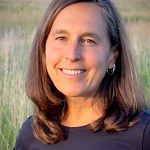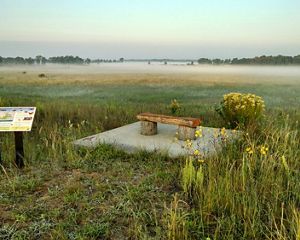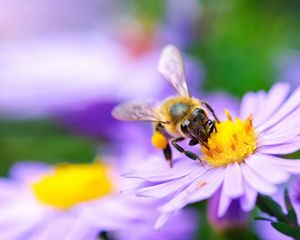
The Magic is Back!
Magic has returned to the prairie! For many people, December is the most magical time of the year—holidays, foods, families, long-starry nights and beautiful snow-covered landscapes. How fitting that this is also the point in the year when the merlins return to Kankakee Sands, and now is the time to see this enchanting falcon!
Ten years ago, when I first wrote about merlins (Falco columbarius) being seen at Kankakee Sands, by the time the article hit the press, the merlins had already left the area. Drat! I’m happy to report that merlins are flying the friendly skies of the Kankakee Sands prairie as I type, so come for a visit soon to witness the magic for yourself!
Check out the magic!
Visit Kankakee SandsMerlins are fast fliers, so trying to identify this 10-13-inch bird in flight might be a little tricky. When perched, you will note that it is about the same size as a stout blue jay. Males and females are dimorphic, the males having gray head and back feathers and the females having brown head and back feathers. Both have a white chin, mottled white chest and barred tail feathers.
Merlins are extremely strong and fast flyers. They are known to fly thirty miles per hour during long migratory flights, and even faster when chasing their dinner. Their aerial swiftness allows them to surprise, overtake and catch their prey while in flight. A merlin’s diet includes small species of birds, as well as dragonflies, rodents, bats and reptiles.
Being tree nesters, the open woodlands and forests of the northern United States and Canada are where you are most likely to find merlins in the spring, summer and fall. In the winter, merlins occupy the grasslands and coasts in the southern states, Mexico and Central America to hunt the wide open, treeless skies. It is during the changing of the seasons that merlins migrate through the Midwest and eastern U.S., which explains why we are seeing them now at Kankakee Sands.
Quote: Alyssa Nyberg
Join us for an upcoming hike on the prairie—"Hike on the Holidays" on Thursday, December 24 or a "New Year's Ramble" on Wednesday, December 31.

Because merlins breed in the northern states and Canada, we aren’t likely to witness their complicated courtship behavior in Indiana. That is too bad because during courtship, the male puts on spectacular flight displays, which include such aerial acrobatics as steep dives, twists, glides, rolls and fluttering. A merlin’s call, however, is something that we do hear in Indiana. The call is a high-pitched, loud, repetitive “ki-ki-ki-ki-ki-ki-ki-keee” cackle of a call.
We are thrilled that the Efroymson Prairies of Kankakee Sands is a migratory stopover for merlins, and for many other bird species as well. When Kankakee Sands was being planned more than 20 years ago, one of the goals of the project was to be a migratory stopover for birds. Success!
Kankakee Sands is free and open to the public for every day of the year from sunrise to sunset. It’s highly likely that during your visit, you may see the state endangered marsh hawk, short-eared owl and rough-legged hawk.
Should you want to have a supported experience on the prairie, consider joining us for an upcoming hike on the prairie, Hike on the Holidays, on Thursday, December 24, from 10 am to 11:30 am or a New Year's Ramble on Wednesday, December 31, from noon to 3 pm (both Central Time). For more information about these two events, visit Friends-of-Sand.com/calendar-of-events or visit nature.org/events.
As the days continue to get colder, the merlins will be leaving our area in search of warmer weather. But they certainly leave a trail of magic on the prairie that we invite you to experience.
November 2025
Who's in Charge?
When you look out over the Kankakee Sands bison pasture and spot a six-foot-tall male bull bison weighing more than 1500 pounds, you might think to yourself, “Now there’s a fella that makes decisions!” And that bull bison certainly does make decisions… for himself. However, when it comes to the bison herd, it’s actually the female bison that are the decision makers.
While the bull bison are off charging one another, it’s the female cows who are taking charge and setting the pace and the direction of the Kankakee Sands herd. Indeed, it is well documented that bison herds are matriarchal in leadership.
Come see the herd!
Visit Kankakee SandsOlivia Schouten, our Kankakee Sands Bison Manager, agrees that it is our oldest females who are making the decisions on when and where to go. These lead cows are typically between the ages of eight and nine years old and are often the largest and healthiest females. They have the wisdom of the Kankakee Sands prairie that they are passing down to the next generations. And for some of the oldest of the cows, they have the knowledge of the South Dakota prairie, their original home before arriving here in 2016 or 2020.
Within hours after birth, calves are up on their feet walking beside mama. This is a position that they will maintain for many months, nearly glued to mama’s side. Unlike cattle, whose calves often group together near a babysitting cow, bison calves do not wander far from their mamas. They stay close to their mothers for nutrition, protection, knowledge and direction. In the fall, these cow-calf pairs, along with the previous year’s yearlings and older female offspring, congregate in family groups of approximately 70 animals. The 3+ year old bison and the bull bison often form smaller groups or remain solitary.
As our Kankakee Sands staff members go about their day of spraying invasive species, monitoring birds, harvesting seeds and welcoming visitors, we catch glimpses of the large bison herd on the prairie. We see them grazing near US 41, then a few hours later, they might be over by the viewing platform, or perhaps they have stopped in at the corral’s watering well, and then off they run to the northern fenceline.
The herd’s movements shape the prairie landscape. Their eating habits change the height of the plants, which affects the types of bird species that utilize the prairie. As bison selectively graze, they determine which plants will and which plants won’t produce seeds. Bison dung serves as fertilizer, as well as food and homes for insects. Bison hooves crush plants, bury seeds and churn up the soil, making space for new plants to grow. When bison wallow on the ground, they create low, open soil areas that fill with water in the spring for frogs and insects to enjoy and later become spaces where new plants can get started.
As I harvest seeds in the bison pasture, I can see and even walk along the hoof beaten paths through the prairie made by the bison. The paths that they take are clear. When and why they walk these particular paths is a bit of a mystery that we are only beginning to unlock.
During the holiday season this winter, stop by Kankakee Sands for a visit. Whether you are like a bull bison traveling by yourself, or a small group of young male bison, or perhaps even a large group like the cows, yearlings and calves. There is room for all of it here at the Kankakee Sands prairie. Just ask the bison—they know!
Let Nature Take Root in Your Inbox
Get the latest news, photos and opportunities near you, delivered monthly. Check out a sample Nature News email.



